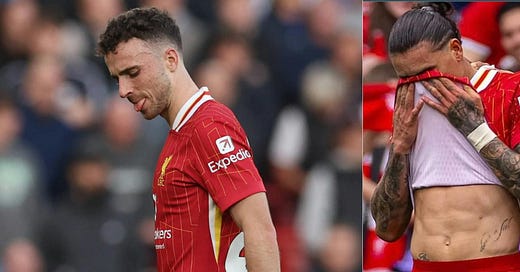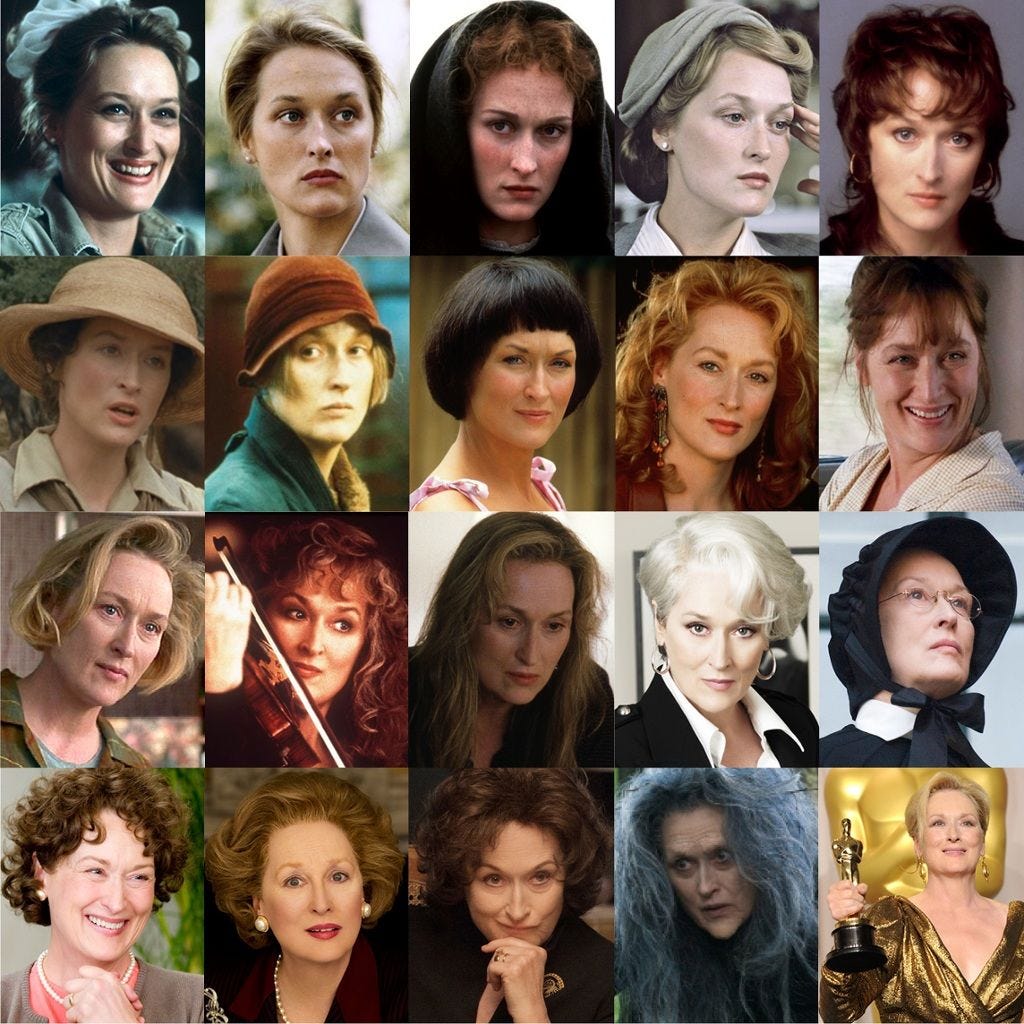The Curious case of the Shot Shy Strikers
Neither man tasked with leading the line registered a shot against Chelsea, and not for the first time this season. How concerned should we be?
“Oh No. Not again”.
Barely five minutes into Liverpool’s big clash with Chelsea, every fan watching will have felt a queasy feeling at the pit of their stomach. Diogo Jota was down, and he wasn’t getting up. The fitness of the man renowned as the most lethal finisher in the squad, the man Jamie Carragher compared to his former teammate Robbie Fowler, has caused more sleepless nights amongst the fanbase than any other. That this was a self-inflicted wound - replays showed that Jota had pulled Tosin Adarabioyo down in the hope of earning the Chelsea defender the same punishment as Arsenal’s William Saliba the night before, only to be rewarded with a knee in the ribs - made it all the more maddening.
The heightened sense of fear of losing Jota is in large part due to a lack of faith in the alternative, but Darwin Núñez earned rightful praise for his work as a substitute, even if it was an atypical display from the Uruguayan. Núñez won all three of his tackles, a team-high nine duels, held the ball well under pressure and even sprayed a beautiful ball into the path of the onrushing Cody Gakpo. The one thing we didn’t get was the one thing you could usually bank on, aside from a yellow card: a shot. Neither of Liverpool’s central strikers recorded a shot of any description, a phenomenon not seen in the league at Anfield since December 2020 against Wolves (Thanks to the Shazam of Stats
).A rare quirk? This season it has become more common. Sunday's game was the third instance in the last five games, with the trip to Wolves and the League Cup win over West Ham producing a similar shutout of the number 9. Liverpool’s nine goals in those three games prove that SOMEBODY is shooting, but regardless of the system, or the presence of world-class wide forwards, the central striker can’t be producing zero shots.
Arne Slot knows this as well as anyone. The six forwards at his disposal represent an embarrassment of riches, and they have contributed 13 of the 15 league goals so far, and 19 of the 25 in all competitions. However, only five have come from the men charged with leading the line, and two of Jota’s four came when playing as a number 10 behind Núñez. When asked about this situation ahead of the game with Crystal Palace, the Head Coach acknowledged it as an issue:
“Maybe it’s also something for us to look at. Although we scored a lot of goals (we need) to bring our striker, whether it’s Diogo or Darwin, even more in positions to score.”
Despite scoring Liverpool’s first and last Premier League goal heading into the game against Chelsea, Jota hasn't reached the deadly efficiency he achieved last season. His 10 goals in 23/24 came at a rate of one every 115 minutes, registering a shot on goal every 28 minutes he was on the pitch. This season, those totals have ballooned to a goal every 248.5 minutes and 35.5 minutes per shot.
Roberto Firmino, the prototype of the striker whose game was about far more than goals, never registered more than 35 minutes per shot across a Premier League season. Minutes per shot isn’t a metric used as often as minutes per goal, but many factors can determine whether shots turn into goals - which is why we have XG. It was instructive that Slot’s answer above wasn’t focused on the finishing ability of his strikers, but on coaches and teammates giving them opportunities to shoot. By counting the shots, we are judging how often a player gets into a position to score, rather than the outcome. Meryl Streep isn’t a legendary actress because she’s won three Academy Awards; it’s because she has earned 21 nominations.
As it turns out, regarding the best the Premier League has to offer, there isn’t a great deal of difference between minutes per shot and minutes per goal. I looked at the top 10 in this season’s top scorers list (which was actually a top 14 as there are six players tied for ninth place) and calculated their minutes per shot and minutes per goal, along with all five of Liverpool’s forwards. Federico Chiesa's 18 minutes in the league meant he was discounted. Núñez’s 196 minutes is a small sample size that should be taken into account, but as a key centre forward option it felt necessary to include him.
The results are clear - the more often you shoot, the more you score. Sounds obvious doesn’t it? Four of the top five for minutes per shot are also at the top in minutes per goal - Noni Madueke and Luis Diaz are the outliers. Neither player, nor Cole Palmer who places 5th in each list, are central strikers, which should eliminate them from this comparison. The same goes for Bryan Mbeumo. There are other important factors to take into consideration. Of those who do play through the middle, very few have one of the greatest goalscorers this league has ever seen on one side, and a strong contender for player of the season so far on the other.
Jhon Duran, Erling Haaland, Raul Jimenez, Kai Havertz, Ollie Watkins, Liam Delap & Chris Wood are all expected to take on the lion’s share of the goalscoring burden when they’re on the pitch. That leaves Danny Welbeck, often paired with Brighton’s club record signing Georginio Rutter, and Nicolas Jackson, who lines up alongside the aforementioned Palmer & Madueke. Both men compare favourably to Jota and Núñez, although interestingly neither are producing at a higher rate than the Liverpool pair were last season.
All of Liverpool’s forwards have seen an increase in their minutes per shot, except Diaz. As noted previously, last season’s rate of 20.79 shots per match was not only unsustainable but likely a result of shots taken when there was a better option available. And yet, there’s no doubt that the game plan would have been to record more attempts than the 8 Liverpool managed on Sunday.
For all of the hand-wringing around the wayward finishing of Núñez last season, I don’t think anyone would agree that not shooting at all is the solution. Strikers rely on confidence more than any other player on the pitch and despite being serenaded by the Anfield crowd for every tackle, he and Jota will know that goals pay the rent. Even accounting for the small sample size, going from 19 to 49 minutes for every shot is a considerable drop.
Whether this is an individual or a system issue will remain to be seen, and Slot will hope that Salah and Diaz can continue to produce while they work it out. But while Jota looks set for another spell on the sidelines, everyone of a Red persuasion would feel better if Darwin could rediscover his shooting boots.








Good read Mo. For me it feels like Szoboszlai as the 10 isn’t really working too well, and that’s part of the problem with our centre forwards not being in the game enough.
Szobo ended last season a bit out of form and not fully fit, didn’t really look much better or fitter in the Euros, and while he now looks fit again, he doesn’t look confident. His tame finish after a superb team move yesterday summed it up, it wasn’t an easy chance, but you would expect a man of his shooting technique to do better.
I think this lack of confidence is affecting his all round game, and while the hard running is undoubtedly there, the quality simply isn’t.
We need Harvey Elliot back sharpish, as that is a guy who creates chances for others for fun. His XA is through the roof, and it will IMO definitely lead to more shots for our central striker if Harvey is the 10.
Szobo needs a break. If Harvey is not imminent, then maybe Macca could be given a chance as the 10 with Jones and Gravenberch behind, or another variation with that trio who could probably all play as the 10.
Our rock solid shape, and depth of attackers, is muddling us through at the moment. If Salah doesn’t get you then Diaz or Gakpo will etc, but longer term we need to solve this issue at the centre of our attack as it’s not really functioning properly.